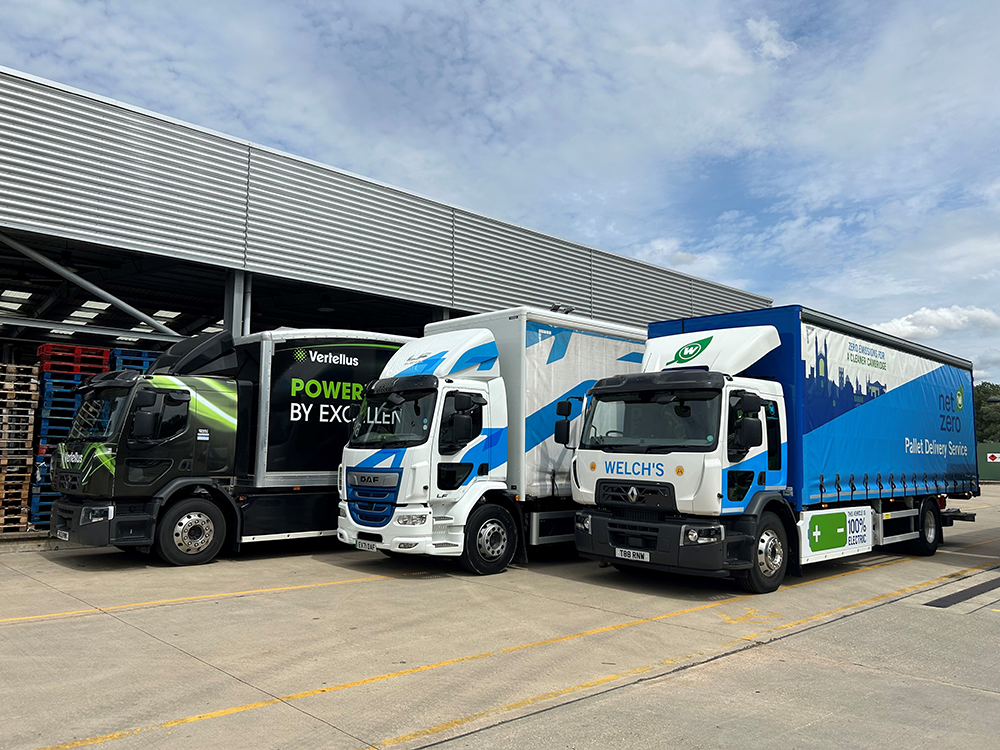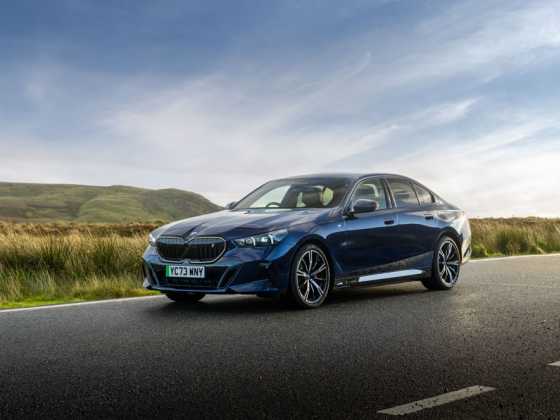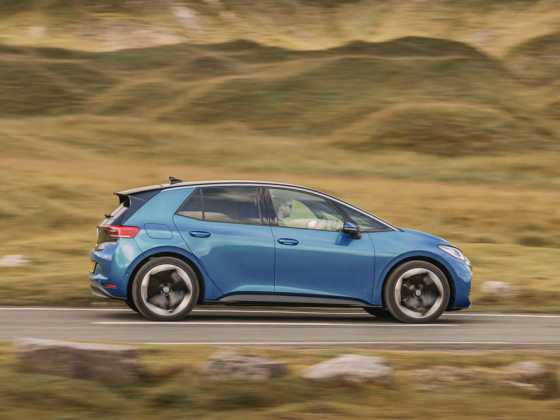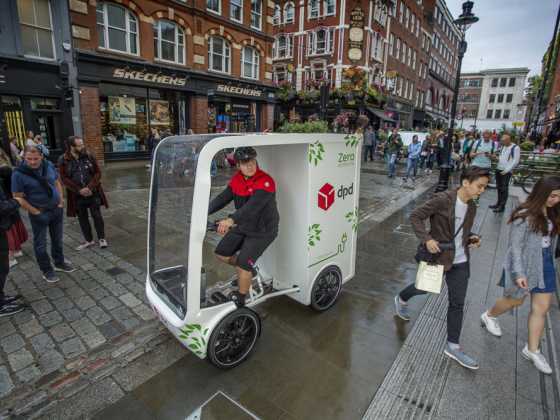A haulage company on the road to net-zero

Chris Welch, director of GREENFLEET’s award-winning fleet, Welch’s Transport, shares his experience of running an electric truck, and gives advice to other logistics operators looking to decarbonise
I’m not one to shy away from talking about decarbonising our industry as my LinkedIn profile regularly showcases. Supported by my team and family, Welch’s Transport is trying to demonstrate how UK hauliers can start to transition to a new age of zero emission operations, especially in the SME space. So, what have we done and what have we learnt?
I will say from the outset that I’m a big advocate of electric and that is what I will discuss here. Whilst hydrogen is an option, we are yet to see any type of real-world application so I can’t envision that it is a likely option for a couple of years. There are steps in the interim which can be taken with the likes of HVO or synthetic fuels. But at what cost? Is the HVO source verified? At the end of the day it simply isn’t a zero emissions option!
We’ve now had over seven months experience of running our Renault eTech D Wide 19t rigid and I feel the industry is starting to grapple with the idea of running lower weight class Battery Electric Vehicles (BEV). Hauliers who operate in the same space as us; (good old-fashion regional hauliers), all operate within pallet networks and thus a good percentage of our fleets are feasible to transition to BEV within current operational parameters today. The first barrier at this point becomes financial, so I highly recommend reading ‘Delivering Net Zero’ by the Green Finance Institute which starts to identify and tackle financial barriers to entry.
But the biggest hurdle is the 44t part of the industry, and the currently impossible questions; “what do we do when it comes to tramping?” the backbone of our industry, and “where has my 4t gone”? This is one is going to take time, it’s ultimately going to be combated by the development of the UK’s infrastructure (be it onsite or public).
We also require some legislative change if we want to maintain our gross weight. In January, I sat on a Department for Transport (DfT) workshop hosted by Renault and led by the decarbonisation power player Andrew Scott earlier. From that session it was comforting to see that the DfT have recognised the requirement to identify solutions to accelerate the decarbonisation journey. Is it as simple as following Europe and increasing axle weights to 13.5t? If so, this still needs legislative intervention to become reality.
In terms of action, the DfT recently launched the Zero Emissions HGV and Infrastructure Demonstrator Programme (ZEHID) with four consortiums. Again, our attitude and work in the decarbonisation space has meant we are the only SME operator who has been invited to join one of these consortiums, eFreight 2030. These are the type of opportunities which I foresee opening up for those operators who want to take the plunge. The same will hopefully be said for our customer bases, especially as there is legislative change coming into effect regarding which sized organisations have to report annually on their emissions.
For those who don’t have access to these kinds of opportunities, there are a number of smaller changes which can be taken on the road to net zero. We’ve implemented AI Route Optimisation Software which reduces mileage, and in some instances, the total number of vehicles deployed. We’ve converted 90 per cent of our double deck fleet to LSTs and this will be completed this year and result in us needing two fewer trailers on the road. But, in my view, the cheapest step is to start analysing your operation – for example, what energy connectivity you have at your site. Engage with bodies like the Energy Saving Trust who will help you understand your own pathway to decarbonisation.
It might sound strange, but even just running a BEV company car will help you start on your journey. Understanding range, knowing what type of chargers return what length of charge, being able to feel what it is like to drive electric, down to the impression it gives customers when you arrive in an electric vehicle - all at two per cent company car tax. But for me it also strengthened my belief in electric. I’ve run electric for three and a half years and I’m now on what I term my ‘second-generation model’. In that time the majority of OEMs have entered the BEV car market with some level of offering which matches their brands positioning in the marketplace, enabling buyers to get better deals. We are already seeing this in the HGV world and again this is also being driven by the sales quotas OEMs have to hit. In any industry, competition drives technological developments and innovation. In one generation of development I maintained the same 0-60, increased the book range from 197 to 341 miles, a charging capacity from 49kwh to 200kwh (1.5hrs to 28mins charge time) and more importantly at 25 per cent less capital outlay.
Attitude also plays a big part; our industry is full of operators who swear by a certain brands and some OEMs have capitalised on this like Scania and its V8 following. I come from a family of petrol heads and motorbike riders and spent my adolescence driving STs and Imprezas, but hand on heart I will never go back to a combustion engine having experienced both sides, because I now understand that this new age of battery electric vehicles brings just as much to the table from a driver experience point of view …. the ability to go 0-60 in 4.6 seconds helps as well.
This attitude has been shared in our allocated eHGV driver pool, I would recommend identifying those initial drivers who are willing to come on that first alternative fuel vehicle journey with you, to be your brand ambassadors, and share their knowledge and experience. As all operators know, the speed at which opinions will travel round the yard is invaluable. Our driver trainer and drivers already understand the new age of kwh per mile from mpg, how to push energy recuperation and look after the battery.
The road isn’t an easy one, we’ve had to swap out our ultra-rapid charger due to hardware issues, and we’ve changed one of the battery cells on our BEV through our truck centre. But these are all learning experiences. Everything is an opportunity to progress; SLAs on your charging infrastructure is key, (anything over 12 hours won’t do) and have you got redundancy built into the way you charge? Our dead battery cell only impacted range and nothing else, so we ran that vehicle up to the hour before it was booked in, and it was back on the road that evening – whilst at the same time I had an ICE rigid off the road with an injector fault for six weeks!
I wouldn’t change the decision we took back in August 2022 to order our first BEV rigid; the decarbonisation of the HGV industry is one of those events which only happens once in a lifetime and gives a true opportunity to shape the industry we live and breathe. The DfT are terming this the ‘year of the lorry’, and we need to stand up and take this opportunity to be listened to.






